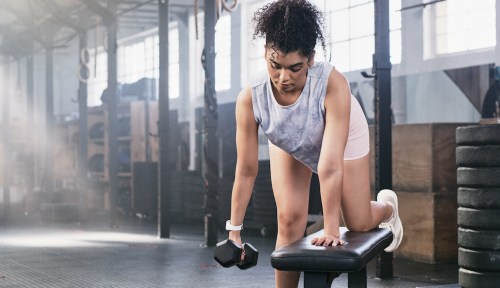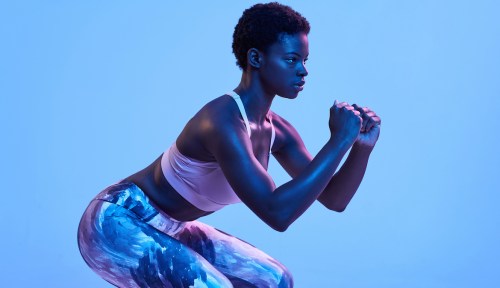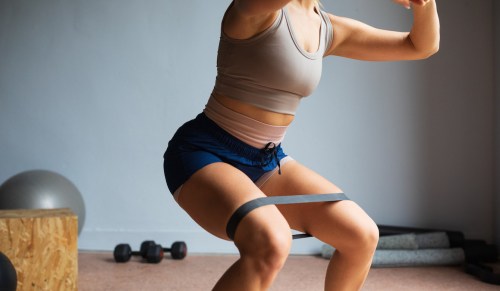Our editors independently select these products. Making a purchase through our links may earn Well+Good a commission
Whenever we do any kind of “pulling” motion—whether we’re opening a drawer or locker, or we need to pick something up—our biceps take center stage. So keeping them strong can make life’s little, mundane tasks a whole lot easier.
Experts in This Article
Ryan Daly, NASM-PES, is a sports performance coach for professional athletes from the NFL and NBA.
And when most of us think of training our biceps, the first thing that comes to mind is that well-known classic: the bicep curl. All you need is to do is grab a dumbbell, and bend at your elbow until you’ve brought your hand up to shoulder height.
The problem? Bicep curls aren’t actually the best way to strengthen your biceps.
“Bicep curls are an isolation exercise, and while isolation exercises can be effective at times, they also have drawbacks,” says Ryan Daly, NASM-PES, a sports performance coach for professional athletes from the NFL and NBA.
Isolation exercises are those that focus on training just one muscle at a time for targeted strength work. By contrast, compound exercises incorporate multiple muscles at once to build well-rounded strength. Both methods have their place, and can help build muscle mass. But isolation exercises like bicep curls can pose a higher risk of injury. “Bicep curls completely isolate all of the tension on your biceps muscle and can often lead to strains or tears, especially for people who haven’t exercised in a while or have had shoulder issues in the past,” Daly explains.
“Bicep curls completely isolate all of the tension on your biceps muscle and can often lead to strains or tears.” —Coach Ryan Daly
Additionally, bicep curls can cause muscular imbalances if you aren’t properly training your other muscles, since they only work the biceps, leaving out other areas of your arms and shoulders.
Instead of doing bicep curls, swap them out for these five bicep curl alternatives that are compound exercises recommended by coach Daly. Doing them consistently will help you more quickly find that upper body strength you’re looking for.
Chin-ups
Equipment needed: A sturdy pull-up bar. Although you can find these at some local parks or install one at home, if you’re new to the move, an assisted pull-up machine at the gym can help by counterbalancing some of your body weight.
How to:
- 1.Grab the bar with an underhand grip (palms facing you), hands about eight inches apart.
- 2.From an extended “hanging” position, slowly pull yourself all the way up to the top, until your chin is above the bar.
- 3.Slowly lower back down until your arms are straight.
- 4.Do three sets, with however many reps you’re able to perform at once without needing a break.
“Chin-ups work your biceps, lats, delts, and core muscles, and they are superior to bicep curls because they help you build strength and definition in your upper arms, shoulders, and back, not just your biceps. Plus they are also great for building grip strength,” says Daly. These are the muscles that you need to push and pull items in your daily life, he adds, so you’ll notice greater ease in everyday tasks.
Single-arm dumbbell rows
Equipment needed: A bench and a dumbbell—the weight shouldn’t be so heavy you can’t control it, says Daly. “If you are a 175-pound male with moderate strength, I’d recommend 40 to 50 pounds, and if you are a 110-pound female with moderate strength, I’d recommend 15 to 20 pounds.”
How to:
- 1.With the dumbbell on the ground, place your left knee on the bench, then bend over to grab the dumbbell. Keep your back straight, your head in line, and the dumbbell directly below your right shoulder.
- 2.Slowly pull the dumbbell straight up toward your shoulder, to the point where you can’t lift it up any further without twisting your upper body.
- 3.Lower the dumbbell back down until your arm is straight, without jerking the weight or rushing through the motion.
- 4.Do eight reps, three sets, then switch sides and repeat with the left arm.
“These rows work your lats, biceps, shoulders and forearm muscles, hitting multiple muscle groups,” says Daly, adding that they also increase stability since they’re a unilateral movement (meaning they train one side of the body at a time).
Reverse-grip bent-over row
Equipment needed: A barbell, plus weights if desired. Daly suggests that male beginners stay under 90 pounds at first, and female beginners start with just the bar.
How to:
- 1.Bend your knees slightly, then fold at the waist and grab the barbell with your palms facing toward you, hands about 8 to 10 inches apart.
- 2.With your back straight and head up, pull the bar up toward your chest slowly, while keeping the rest of your body stationary.
- 3.Slowly lower the bar until your arms are once again fully extended.
- 4.Repeat for a total of 8 to 10 reps and three sets.
“This exercise works your upper back muscles, like your traps, lats, and shoulders, but it will also put a fair amount of strain on the biceps,” says Daly.
Reverse-grip cable pulldown
Equipment needed: A cable pulldown machine, set to an appropriate weight for your fitness level. “If you’re a beginner, start with about half your body weight,” says Daly.
How to:
- 1.Sitting upright, grab the pulldown bar with both hands (palms facing toward you), keeping them about 8 to 10 inches apart.
- 2.Keep your feet planted firmly on the floor as you lower the weight down until the bar reaches your chest.
- 3.Slowly bring the bar back up until your arms are fully extended.
- 4.Repeat for a total of 8 to 10 reps and three sets.
“Reverse-grip lat pulldowns will strengthen your biceps, lats, shoulders and forearms,” says Daly. However, there’s some core work, too: When pulling down, you’re also activating your center to maintain your form and keep that upright posture.
Seated cable rows
Equipment needed: A cable machine, with a two-handed grip attached, set to about half your body weight if you’re a beginner.
How to:
- 1.Sitting upright, face the cable machine and grab the grip bar with both hands.
- 2.Keep your feet planted firmly as you slowly bring the weight toward you until the grip reaches your chest.
- 3.Slowly return the bar back towards the cable machine until your arms are once again extended.
- 4.Repeat for a total of 8 to 10 reps and three sets.
Remember: Form is important so you don’t get injured. “Don’t round your back or jerk the weight too fast,” says Daly.
Working your lats, biceps and forearm muscles, “seated cable rows engage multiple muscles at the same time, allowing you to build strength throughout your entire upper body,” he says. It also helps you work on maintaining stability and paying keen attention to correct form while working out.
Oh hi! You look like someone who loves free workouts, discounts for cutting-edge wellness brands, and exclusive Well+Good content. Sign up for Well+, our online community of wellness insiders, and unlock your rewards instantly.
Sign Up for Our Daily Newsletter
Get all the latest in wellness, trends, food, fitness, beauty, and more delivered right to your inbox.
Got it, you've been added to our email list.











